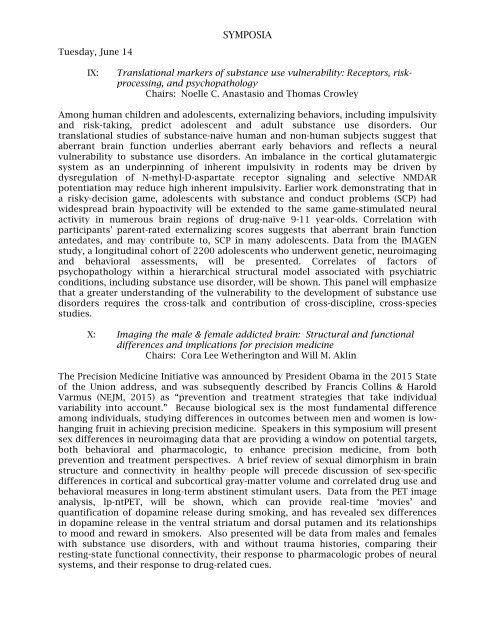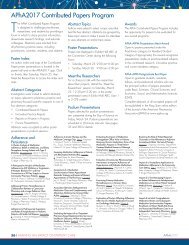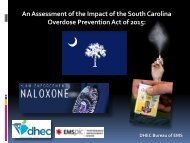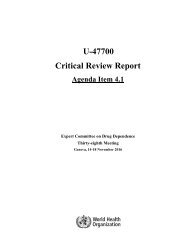CPDD 78th Annual Scientific Meeting Program
2016-78th-CPDD-Program-Book-6-07-16FINAL
2016-78th-CPDD-Program-Book-6-07-16FINAL
You also want an ePaper? Increase the reach of your titles
YUMPU automatically turns print PDFs into web optimized ePapers that Google loves.
SYMPOSIA<br />
Tuesday, June 14<br />
IX:<br />
Translational markers of substance use vulnerability: Receptors, riskprocessing,<br />
and psychopathology<br />
Chairs: Noelle C. Anastasio and Thomas Crowley<br />
Among human children and adolescents, externalizing behaviors, including impulsivity<br />
and risk-taking, predict adolescent and adult substance use disorders. Our<br />
translational studies of substance-naive human and non-human subjects suggest that<br />
aberrant brain function underlies aberrant early behaviors and reflects a neural<br />
vulnerability to substance use disorders. An imbalance in the cortical glutamatergic<br />
system as an underpinning of inherent impulsivity in rodents may be driven by<br />
dysregulation of N-methyl-D-aspartate receptor signaling and selective NMDAR<br />
potentiation may reduce high inherent impulsivity. Earlier work demonstrating that in<br />
a risky-decision game, adolescents with substance and conduct problems (SCP) had<br />
widespread brain hypoactivity will be extended to the same game-stimulated neural<br />
activity in numerous brain regions of drug-naïve 9-11 year-olds. Correlation with<br />
participants' parent-rated externalizing scores suggests that aberrant brain function<br />
antedates, and may contribute to, SCP in many adolescents. Data from the IMAGEN<br />
study, a longitudinal cohort of 2200 adolescents who underwent genetic, neuroimaging<br />
and behavioral assessments, will be presented. Correlates of factors of<br />
psychopathology within a hierarchical structural model associated with psychiatric<br />
conditions, including substance use disorder, will be shown. This panel will emphasize<br />
that a greater understanding of the vulnerability to the development of substance use<br />
disorders requires the cross-talk and contribution of cross-discipline, cross-species<br />
studies.<br />
X: Imaging the male & female addicted brain: Structural and functional<br />
differences and implications for precision medicine<br />
Chairs: Cora Lee Wetherington and Will M. Aklin<br />
The Precision Medicine Initiative was announced by President Obama in the 2015 State<br />
of the Union address, and was subsequently described by Francis Collins & Harold<br />
Varmus (NEJM, 2015) as “prevention and treatment strategies that take individual<br />
variability into account.” Because biological sex is the most fundamental difference<br />
among individuals, studying differences in outcomes between men and women is lowhanging<br />
fruit in achieving precision medicine. Speakers in this symposium will present<br />
sex differences in neuroimaging data that are providing a window on potential targets,<br />
both behavioral and pharmacologic, to enhance precision medicine, from both<br />
prevention and treatment perspectives. A brief review of sexual dimorphism in brain<br />
structure and connectivity in healthy people will precede discussion of sex-specific<br />
differences in cortical and subcortical gray-matter volume and correlated drug use and<br />
behavioral measures in long-term abstinent stimulant users. Data from the PET image<br />
analysis, lp-ntPET, will be shown, which can provide real-time ‘movies’ and<br />
quantification of dopamine release during smoking, and has revealed sex differences<br />
in dopamine release in the ventral striatum and dorsal putamen and its relationships<br />
to mood and reward in smokers. Also presented will be data from males and females<br />
with substance use disorders, with and without trauma histories, comparing their<br />
resting-state functional connectivity, their response to pharmacologic probes of neural<br />
systems, and their response to drug-related cues.







